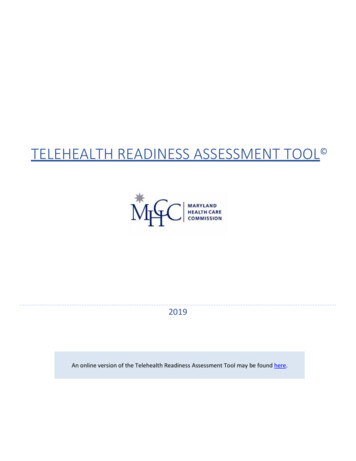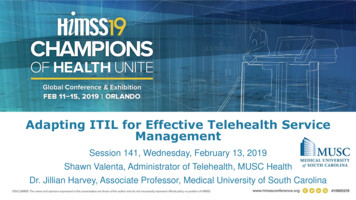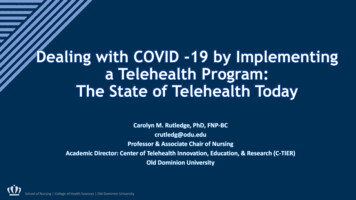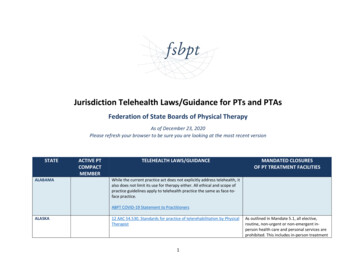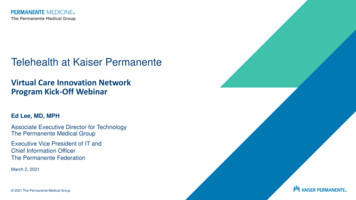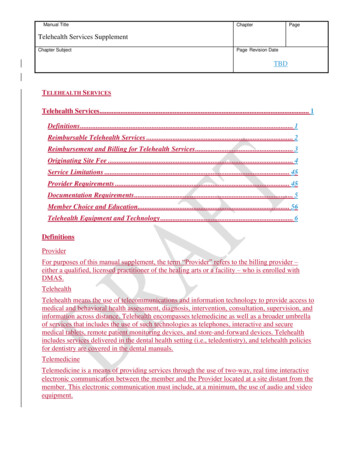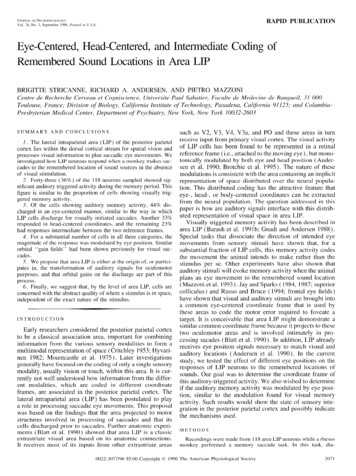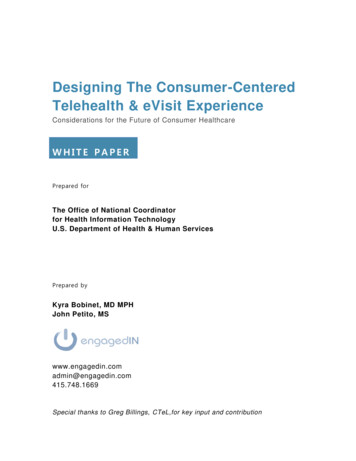
Transcription
Designing The Consumer-CenteredTelehealth & eVisit ExperienceConsiderations for the Future of Consumer HealthcareWHITE PAPERPrepared forThe Office of National Coordinatorfor Health Information TechnologyU.S. Department of Health & Human ServicesPrepared byKyra Bobinet, MD MPHJohn Petito, Special thanks to Greg Billings, CTeL,for key input and contribution
SUMMARYThis white paper covers key elements of design for consumer -centeredtelehealth. Given the rapid growth of telehealth and overall disruption ofhealthcare reimbursement and care delivery, the Office of the NationalCoordinator for Health Information Technology (ONC) commissioned adesign session focused on this topic on April 10, 2015 with over 30stakeholders in attendance.Key findings from this design session include the following guidelines for aconsumer-centered telehealth experience:1.2.3.4.5.6.7.8.9.There cannot be friction for the user.Team-based care must include smart triggers.Real world and online world must converge.We must be sensitive to data overload.Consumers are the hubs of their own healthcare data.Converge data for interactions to be safe and meaningful.Expand role for care team based on new data triggers.Integrate technology and human interaction in the physical world.Increase focus on patient data security.In addition, and while not necessarily endorsed by ONC, several issues wereraised that warrant further exploration and consideration:First, telehealth is seen as a means to scale quality, lower cost, and increaseconvenience, however, integration of data back to the primary health recordis needed to avoid fragmenting care and potentially impacting patient safety.Second, consumer-centered telehealth technologies are rapidly evolving tomeet the “on-demand economy” expectations of consumers, which potentiallyoffers them greater control over their health and data.Third, consumers must own and have access to their data and fullyintegrated telehealth may offer this access, especially important for moredisenfranchised, vulnerable, or rural populations.Finally, interoperability efforts are essential to keep pace with theproliferation of telehealth solutions that are finding their way to consumers.The ONC efforts around this, as well as Blue Button, moving forward wouldassist in secure and safe data support to this rapidly evolving field.ii
CONTENTSIntroduction . .1Design Session Background . . .3Structure of Design Session . . .3Changing Telehealth Landscape . .6An Industry Defining Itself . .8Integrated vs. Fractured Care and Data . . .10Challenges Identified from the Consumer-Centered Telehealth DesignSession . .14Future State: Consumer-Centered Telehealth Design PrinciplesConclusion . 16Conclusion . .20Appendix .22iii
INTRODUCTIONThe Office of the National Coordinator for Health Information Technology(ONC) engaged the behavior design firm, engagedIN, to conduct backgroundresearch and facilitate a design session with leading experts in healthinformation technology (health IT) and telehealth. The goal of this sessionwas for the ONC to develop an informed perspective on the design andbehavioral considerations for consumer-centered telehealth, This white paperwas written to reflect the findings from this research, as well as novelsolutions and forward thinking recommendations created during the livedesign session. The ONC was primarily interested in better understandingthe potential of telehealth capabilities to enable a consumer -centeredhealthcare ecosystem.Both background research and the design session findings point to the futurefor telehealth-enabled care delivery as bright. There has been a significantamount of innovation from vendors and startups as industry stakeholders(including employers, providers, and payers) have embraced, and consumershave become increasingly open to, new care delivery models. These newmodels have the potential to increase convenience, improve access andbetter manage costs. Industry associations such as the AmericanTelemedicine Association (ATA), the Alliance for Connected Care, and theCenter for Telehealth and e-Health Law (CTeL), have proposed thoughtfulapproaches to define and structure these new care modalities, and their workcan be instructive for policy makers and regulators. 1 Finally, ensuring a safeand convenient integration of telehealth into mainstream care requires significantforethought and strategic planning. This implies engaging representatives of relevantstakeholders to co-design the telehealth-enabled delivery system of the future.This white paper, although touching upon many aspects of the current stateregulatory and technological ecosystem of telehealth, is not to be interpretedas a definitive assessment of the telehealth landscape. It also is not meant tobe interpreted as a policy statement about the ONC’s position on telehealth.Rather, it provides: a) an overview of the purpose, structure, and frameworksused to facilitate the design session, b) a cursory evaluation of the currentstate telehealth landscape (as implicated by output from the design session),c) current state challenges resolved with future state designs, and finally, d)a review of the principles for future telehealth design that were highlighted bydesign session elemedicine-Medicine-Principles-1.0.pdf1
DESIGN SESSION BACKGROUNDAs part of its mission, ONC aims to coordinate the adoption and use of healthIT to support broader objectives of integrating data and continuity acrossdiverse care delivery models towards better health outcomes. Additionally,the draft Federal Health IT Strategic Plan (2015-2020), for which ONC hasmade commitments, includes a stated goal to expand the adoption and useof a broader set of technologies, including telehealth and mobile health.Telehealth adoption is further underscored and encouraged in theConnecting Health and Care for the Nation: A Shared NationwideInteroperability Roadmap 2. This design session provided an opportunity togather subject matter experts, and develop an understanding of current andfuture novel use cases for telehealth,At the request of the ONC, engagedIN held a half-day session on Designingthe Consumer-Centered Telehealth Experience. Hosted at the U.S.Department of Health and Human Services headquarters in Washington, DCon Friday, April 10th, 2015, the session included over 40 private and publicsector stakeholders with representatives from consumer, provider, payer,vendor, health IT organizations, and other federal agencies (Appendix A).Using design-thinking exercises, participants provided input and insight intopotential future consumer healthcare experiences enabled by telehealth, a swell as challenges due to current limitations. The format of a design sessionwas selected as a means to extract the distinct features of a consumercentered experience, as well as the next generatio n of design for consumers.STRUCTURE OF DESIGN SESSIONThe attendees of the session shared their perspectives in a fast-paceddesign session focused on the next generation of consumer-centeredtelehealth and eVisits. Participants self-organized into small groups andselected one of four consumer use case prompts to focus their designthinking: 1) rural access to care; 2) after hours urgent care; 3) post-acutepassive monitoring with active outreach triggers; and, 4) chronic care passivemonitoring with constant data and occasional outreach triggers. These usecase prompts were meant to represent a range of real life clinical scenariosfaced by patients within the current healthcare delivery system. The usecases also reflected scenarios addressed by telehealth and eVisit modelstoday.“Connecting Health and care for the Nation: A Shared Nationwide Interoperability ion-1.0.pdf22
Groups engaged in the design process in several steps. First, they wereasked to design for empathy with their user. They developed thepsychological, emotional, and demographic profile of their user persona(e.g., pediatric user with rare disease in rural community), the clinicalscenario (e.g., ongoing health issues but limited access to specialist in person), any geographic constraints (e.g., multi-hour drive from nearestmedical center), and timing considerations (e.g., after hours). Next, teamsused several behavioral and neuroscience concepts to guide their support orintervention design using real or imagined features of telehealth. They wereinstructed in designing for the subconscious and aggregate emotionalexperience of users. They then used their robust user personas as thefoundation for spawning novel design solutions centered on the needs oftheir user. Participants were instructed to design without the constraints ofcurrent technology, workforce training, data integration, or other limitations .Their design solutions were meant to represent what would be possible in astrictly consumer-centered design. Participants were also asked to use “FastBrain / Slow Brain” principles—principles renamed by engagedIN and derivedfrom the work of Dr. Daniel Kahneman, a Nobel Laureate behavioralpsychologist—to incorporate elements of behavioral psychology design intothe solutions they had developed. These two groups of principles weredefined as follows:Fast Brain (aka System 1): Fast, automatic, frequent, emotional, stereotypic,(Example: all thoughtless habits, engrained routines, mannerisms, currentuse of technology (i.e. what we are used to), mental models, short -cuts,assumptions (biases), rules-of-thumb, heuristics, self-protective reactions(emotional or fight-flight) mindful, conscious)Slow Brain (aka System 2): Slow, effortful, infrequent, logical, calculating,careful, sub/unconscious, familiar, habitual (Example: all plans, goals,problem-solving, intentional actions, instructions, training, tutorials, (most)first-times)By incorporating elements of psychology- and behavior design thinking intothe groups’ telehealth-enabled use cases, designs would be matched moreclosely to the thoughts and feelings of the consumer. Additionally, thegroups, in conjunction with ONC counterparts, identified data flows andinfrastructure that would be needed or developed to support these futurestate designs.3
Ultimately, this session reflected for the ONC: 1) understanding how industryparticipants think about the evolution of telehealth and emergingtechnologies; and 2) identifying data interoperability challenges and barriersthat may exist in the current infrastructure or may emerge as consumercentered experiences evolve.CHANGING TELEHEALTH LANDSCAPEWhile telehealth is not new, numerous factors have recently been drivingrapid growth and adoption of telehealth. According to Ken Research, in2013, the market for telehealth generated annual revenue of 9.6 billion,representing growth of 60 percent from 2012, when overall revenue was 6billion. This research also indicates that the telehealth market is expected togrow by approximately 32% compound annual growth rate (CAGR) from2013-2018 3. Factors spurring telehealth adoption include policy andreimbursement shifts, secular trends in technology, changing consumerpreferences, and evolving technology. While the below is not acomprehensive list, let’s examine some of the key drivers of these trends: Continued Rise of Healthcare Consumerism. 2014 saw the singlelargest one-year increase in enrollment in high-deductible consumerdriven health plans, from 18% to 23% of all covered employees 4. Asemployers increasingly offer these plans to employees, and asemployees increasingly shoulder a larger portion of out-of-pocketcosts, telehealth becomes an increasingly appealing option forconsumers to access care for the lowest-cost with the greatest degreeof choice. Consumer Expectations for Convenience. Across many industries,consumers increasingly seek and expect convenience. Coined the“On-Demand Economy”, this quest for convenience has attracted over 4.8 billion in investment from institutional investors thus far 5. Thisconsumer mindset is now hitting healthcare, as seen in the recent riseof urgent care centers, eVisits, health kiosks, and an explosion of“2015: Another Unstoppable Year for Telehealth.” Alliance for Connected nstoppable-year-telehealth/. Accessed: April 20, 2015.4 “Costs Slow as Health Care Consumerism Grows.” Watts, Tracy and Umland, Beth. ow-health-care-consumerism-grows/. Accessed: April 20, 2015.5 “The ‘On-Demand Economy’ Is Revolutionizing Consumer Behavior – Here’s How.” Jaconi, Mike. July 13, economy-2014-7. Accessed: April 20, 2015.34
health and wellness mobile apps, now numbering over 100,000 6. Thistrend will continue to provide tailwind for the adoption of telehealth. Shifting Revenue Models that Reward Value, Not Volume. Today,744 Accountable Care Organizations (ACOs) cover a total of 23.5million lives 7. The number of organizations and covered lives hasgrown more than tenfold since 2011. The January 2015 announcementby the U.S. Department of Health and Human Services (HHS) to move50 percent of Medicare payments towards alternative payment modelsby the end of 2018 will bolster this trend 8. UnitedHealthcare, the largestpayer in the U.S., announced in February 2015 that its total payments tophysicians and hospitals that are tied to value-based arrangements havenearly tripled in the last three years to 38 billion. Rewarding providers forvalue requires moving encounters to lower cost options whilemaintaining quality care delivery. Telehealth will be a critical pillarenabling the cost-effective and safe provision of value-based care. Ubiquitous and Affordable Mobile Broadband. Globally, and in theUnited States, smart phone adoption and broadband use are on therise. It is estimated that by 2016, smart phone subscriptions willoutnumber those for basic phones, and mobile data traffic is set togrow at a compound annual growth rate of 40 percent 9. With an almostubiquitous mobile technology and data-enabled infrastructure, thestage has been set for healthcare to deliver new, more convenientaccess points for consumers needing to interface with the medicalsystem.“Mobile health app revenue to grow tenfold by 2017, study predicts.” Frank, John. May 22, 522/BLOG/305229997. Accessed: April 20, 2015.7 “Growth and Dispersion of Accountable Care Organizations in 2015.” Muhlestein, David. HealthAffairs s-in-20152/. Accessed: April 20, 2015.8 “Better, Smarter, Healthier: In historic announcement, HHS sets clear goals and timeline for shifting Medicarereimbursements from volume to value.” January 26, 50126a.html. Accessed: April 26, 2015.9 “Ericsson Mobility Report On The Pulse of the Networked Society. February n-mobility-report-feb-2015-interim.pdf. Accessed: April 20,2015.65
AN INDUSTRY DEFINING ITSELFThe increased demand for, and adoption of, telehealth solutions has resultedin a diverse and expanding industry of stakeholders and definitions. Whilethe ONC is not proposing any policy position on defining telehealth, it isworth noting that many definitions exist to define this space. Prior to thedesign session, attendees were briefed by leaders in federal government(Marc Hartstein of the Centers for Medicare & Medicaid Services (CMS) andJohn Peters of the US Department of Veterans Affairs (VA)) on existingtelehealth policies and the below were some of the definitions shared. Alsoincluded are some definitions from trade associations – note this is not acomprehensive list of all telehealth definitions that exist.DEFINITIONS[01]Medicare Telehealth ServicesLimited to services that normally require a face-to-face interactionwith the patient’s physician such as an office visit or a psychotherapyservice. These services are furnished via a telecommunicationssystem where the physician or practitioner is not at the same locationas the beneficiary. The communication must include two -way, realtime interactive audio and video communication between the patientand physician or practitioner 10.[02]Medicaid TelehealthTo improve a patient's health by permitting two-way, real timeinteractive communication between the patient, and the physician orpractitioner at the distant site. This electronic communication meansthe use of interactive telecommunications equipment that includes, ata minimum, audio and video equipment 11.[03]Veterans Health AdministrationClinical Video TelehealthReal-time video consultation thatcovers over 45 clinical specialties.Home TelehealthCare and case management of chronicconditions and provision of noninstitutional care support to patients.Presentation by Marc Hartstein to Office of the National Coordinator for Health Information Technology. April10, 2015.11 “Telemedicine. l. Accessed: April 20, 2015.106
Store & Forward TelehealthUses in-home and mobile technologiesto manage diabetes, chronic heartfailure, hypertension, obesity, traumaticbrain injury, depression, etc.Includes services where images orother data is captured and sent forreading later by a clinician 12.There also exist definitions put forth from trade groups and industryassociations:[04]American Telemedicine AssociationTelemedicine is the use of medical information exchanged from onesite to another via electronic communications to improve a patient’sclinical health status. Telemedicine includes a growing variety ofapplications and services using two-way video, email, smart phones,wireless tools, and other forms of telecommunications technology 13.[05]Alliance for Connected CareConnected Care is the real-time, electronic communication between apatient and a provider, including telehealth, remote patientmonitoring, and secure email communication between clinicians andtheir patients 14. The current telehealth landscape is comprised ofsolutions ranging from virtual visits (also known as eVisits) to “storeand forward” (remote imaging and diagnostic capabilities) to remotepatient monitoring (using devices and communications where thepatient stays).INTEGRATED VS. FRACTURED CARE & DATAConcern over data cohesion emerged as a key discussion point in the designsession. Telehealth solutions vary widely in the degree to which theyintegrate back into the traditional delivery system, connect the Primary CarePhysician (PCP)-patient relationship and load to the main health record. As aresult, tradeoffs between consumer convenience and data cohesion havePresentation by John Peters to the Office of the National Coordinator for Health Information Technology. April10, 2015.13 “What is Telemedicine?” what-istelemedicine#.VTKhC5PthKo. Accessed: April 20, 2015.14 “What is Connected Care?” are/. Accessed: April 20,2015.127
arisen as a potential issue for patient safety and continuity of care. In Figure1, we represent a model of various degrees of tradeoffs that telehealth couldenable care and data. This cursory model offers a schema for evaluating howindividual telehealth solutions are contributing to integration or whether theyare potentially fracturing care.Figure 1. Model of how telehealth can promote integration, versus fracturing,of care and data.Four levels of integration-to-fracturing of care.[1] Integrated Care. The center of this model, level 1, contains 100% ofthe consumer’s health relationships, whether with primary care provider(PCPs), family/caregivers, or ancillary professionals. It represents 100% ofall health record data. It is the same as many industry terms, synonymous tothe “medical home”, “universal patient record”, and supports patient (andcaregiver) self-efficacy. Additionally, consumers, and their care team, gather,8
diagnose, translate and act on healthful insights based on their healthliteracy.[2] Telehealth-enabled. Due to disruptive forces aforementioned, suchas the need to scale affordable, quality care, telehealth in this level supportsthe original Integrated Care relationships between the consumer and theircare team (including caregivers). Telehealth simply enables the in-personcare team to be more efficient, available, and scalable.Telehealth solutions that qualify as level 2 would not fundamentally alter preexisting in-person, long-term care team relationships, but use technology toenrich them and capture all data and care back to the main health record. Anexample of a level 2 telehealth use case would be a live, secure videoenabled consult between a doctor-patient who have a pre-existing, long-termrelationship as long as all data from the consult loaded back to the patient’sprimary medical record. Diagnoses could be made based on thoroughknowledge of the patient’s history and include the use of peripheraltelehealth devices. At level 2, a pre-existing relationship is simply continuedby using technology as an enabler.[3] Extended Integration. In level 3, telehealth still helps to integratecare but the risk of fracturing of care and data emerges due to the extensionof care through additional provider relationships that are st ill peripherallylinked to the care team. An example would be nurse remote monitoring thatsupports the PCP-patient relationship but adds additional clinicians andancillary professionals. Other examples include referrals to specialists, useof telehealth in rural clinician shortages, home visits, integrated urgent careand online eVisits with referral clinicians. Even though the sheer number ofadditional clinicians may pose a risk for fracturing, the data from each ofthese ideally would be integrated back into the primary health record, therebymitigating it.[4] Outside Care. The farthest out, layer 4, of the model, and furthestfrom the center of Integrated Care, would lay telehealth that functionscompletely separately from the existing care team and their network. Thiswould include encounters that are one-off, stand-alone, like some employersponsored eVisits, community-based retail clinics and kiosks, as well assolely consumer apps and devices.Telehealth technologies in this layer run the risk of diffusing patient data anddisrupting continuity of care without an integrated data. Risks to the9
consumer in this layer may include repeated tests, incomplete diagnoses(due to partial data), inappropriate use of telehealth where in-person exam isindicated, medication interactions, and low patient adherence. This outerlayer of the model has seen rapid proliferation of new models and companiestoo numerous to provide a comprehensive review here. The following notableexamples show the types of innovations increasingly available to consumerstoday:Employer-sponsored eVisits: Companies such as Teladoc, AmericanWell, MDLive to name a few are made available to employees of largecompanies by their insurance carriers or employers. These offeringstout convenience and improved access to after-hours care. Some earlyevidence from a study produced by the RAND Corporation on Teladocdemonstrated improved convenience, and perhaps cost, for a limitedset of clinical conditions. The study’s population of telehealth visitorsmade more than one third of their Teladoc visits on weekends orholidays, and experienced shorter clinician wait times 15. Despite itsconvenience, the information generated from these encounters do notcurrently get integrated back into the patient’s medical record, anddata does not flow back into the core, presenting risks outlined above.Retail-pharmacy telehealth offerings: Retail pharmacy chains havealso been entering the telehealth space. A notable recent example isthe partnership announced between Walgreens and MDLive, providingaccess for consumers to board-certified doctors through MDLive’splatform (initially offered only for customers in California andMichigan) 16. While this relationship could create the potential forgreater care coordination and information flow between pharmacyrecords and providers, driven by the consumer, it still lacks thefundamental connection back into the Core medical record held byproviders and other care team members.Payer-sponsored eVisits: In April 2015, UnitedHealthcare announced itwill be expanding consumers’ access to affordable health care options with itsvirtual physician visit benefit coverage. By the end of 2016, up to 20 millioncommercial plan participants across the country will be able to choose fromin-network virtual care provider groups, then see and speak with a doctor“First Assessment of National Telemedicine Services Finds Efforts Appear to Expand Access to Acute MedicalCare.” February 4, 2014. thKp. Accessed: April 20, 2015.16 “Walgreens Joins MDLive To Access Doctors Via Telemedicine.” December 8, telehealth/2/. Accessed: April 20, 2015.1510
using real-time audio and video technology to obtain a diagnosis and anynecessary prescriptions for minor medical needs.While there has been an explosion of new offerings and models of telehealth,two things are clear: 1) there is a real need for additional objective evidenceon the cost, quality, and access implications of these new telehealthinnovations far from the core, especially as they move from niche offerings tomainstream; and, 2) the need to solve for consumer-driven data exchange isemerging as a critical element in supporting these models and connectingthem back to the Core. An early initiative that moves us closer in thisdirection is the Blue Button Initiative, spearheaded by the ONC. This initiativefocused on giving consumers easier online access to their health data,enabling portability so that patients can securely move their data as theyplease; rather than seeing the data reside in legacy systems owned bypayers and health systems. However, Blue Button ubiquity is far fromcomplete and the growth of telehealth further identifies a fragmentation riskfor which industry should align and expand Blue Button. As a relatedopportunity, additional focus is needed on enabling data exchange in orderfor these new models to have positive, widespread impacts on care deliverywithout fracturing care or jeopardizing patient safety.CHALLENGES IDENTIFIED FROM THE CONSUMERCENTERED TELEHEALTH DESIGN SESSIONParticipants in the Consumer-centered Telehealth Design Session identifiedcommon requirements and challenges as they designed for the nextgeneration of consumer telehealth. Each group of participants created a usecase for future telehealth that was highly convenient, and centered aroundconsumer needs. This was perhaps a different focus from existing caredelivery entities that may focus on their own facility’s needs, e.g. coveringbrick and mortar costs with revenue from in-person care, at the consumer’sexpense and inconvenience. These designs, which will be discussed ingreater detail in the next section, yielded basic tenets of a consumercentered design. However, the participants also highlighted severalchallenges existing in the current state environment and, among these, threethemes of challenges emerged across all of the groups:1. Payment for Telehealth ServicesCurrent reimbursement from Medicare is limited to a subset of the telehealthuse cases existing in the market. In the commercial market, employe rs haveembraced specific uses of telehealth as well. According to a 2014 TowersWatson survey, 37 percent of employers expected to offer their employees a11
telehealth benefit by 2015 for nonemergency issues 17. Despite a recentgrowth in reimbursement models for telehealth services, the consumercentered telehealth use cases of tomorrow will require additional forms ofreimbursement for consumer adoption. Some current reimbursement rulesconstrain activities that could be cost savings (e.g., group visits or leveragingancillary clinical staff for patient care in certain use cases).2. Physician LicensureCurrently, most states require physicians to be licensed to practice in theoriginating site's state, and some states require providers using telehealthtechnology across state lines to have a valid state license in the state wherethe patient is located. Opportunities are growing for multi-state or regionalconsortiums for licensure with some experts pointing to federal licensure as apossible solution. Either way, a streamlined physician licensure process, thatalso tracks and exacts accountability for bad actors, will enable an expansionof telehealth, and will open up the breadth and depth of provider supply 18.3. Care Fragmentation and Data FracturingRecent research by the RAND Corporation indicated that telemedicinemay expand access and reduce costs for specific types of healthconcerns. However, researchers who performed the study indicated thatfurther investigation is needed to better assess the quality and safety ofthese services, and raised concerns of care fragmentation from not havingaccess
consumer-centered telehealth experience: 1. There cannot be friction for the user. 2. Team-based care must include smart triggers. 3. Real world and online world must converge. 4. We must be sensitive to data overload. 5. Consumers are the hubs of their own healthcare data. 6. Con

